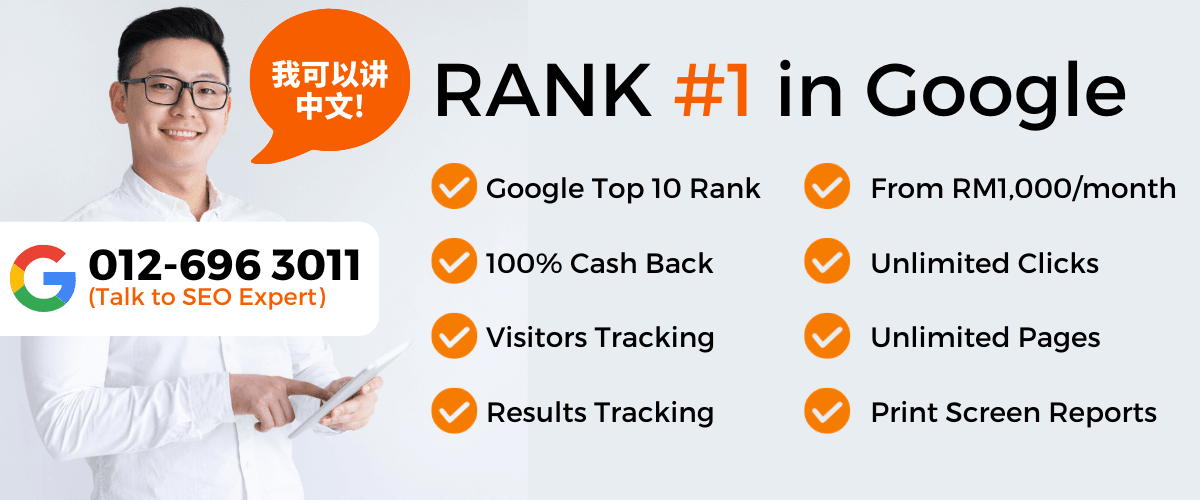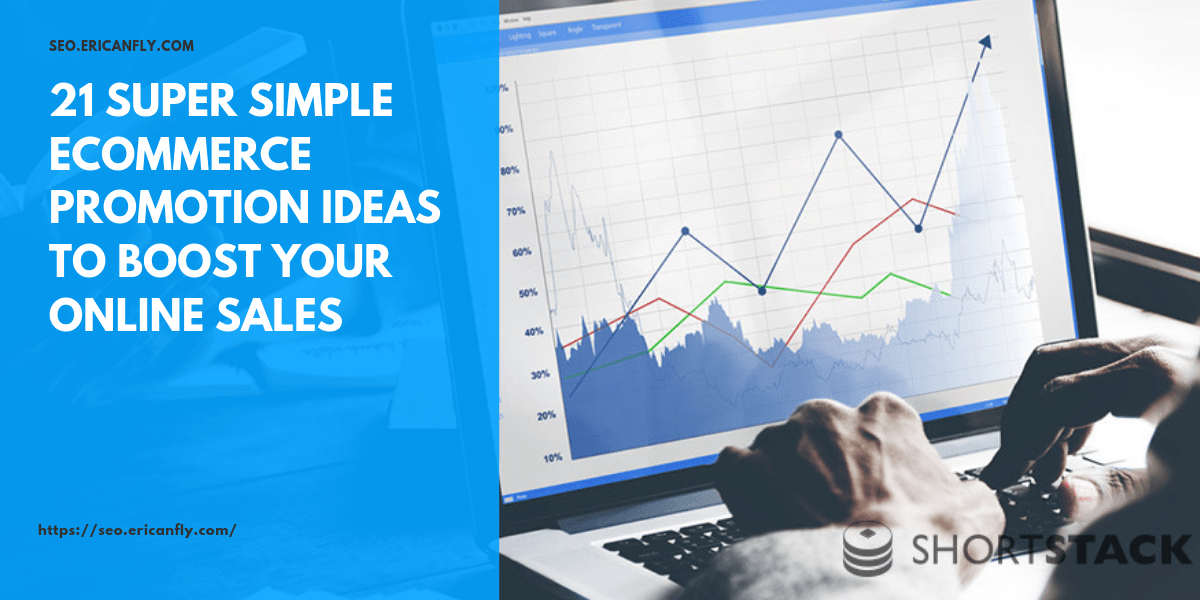
25 Jul 21 Super Simple eCommerce Promotion Ideas to Boost Your Online Sales
With 67% of millennials and 56% of Gen X now preferring to shop online…
It’s impossible to ignore the sheer size of the opportunity presented by online stores for modern businesses.
As interest grows and technology improves, the barrier to entry for starting an eCommerce business is almost non-existent. Just about anyone can put together a product page, organize a dropshipping agreement on Alibaba, and try their hand at online retail.
So, how do you get your products in front of potential buyers at the most opportune moment in their purchasing decision process? What are you doing differently to your growing list of competitors?
Most new eCommerce businesses see the first stage of growth achieved through a handful of promotional tactics. For some it’s social media, for others it’s search engine marketing, and for others, it’s paid advertising. But as your business matures and these tactics plateau, you need to think outside of the box to continue your growth trajectory.
Here are 21 super simple eCommerce promotion ideas that will help you boost sales:
1. Contests, sweepstakes or giveaways
Granted, we speak a lot about contests, sweepstakes, and giveaways here at ShortStack…. After all, our platform helps you design and deliver these promotional campaigns.
But, whether you choose to use ShortStack or not, the power of this form of marketing campaign for eCommerce stores shouldn’t be ignored.
Contests capture your audience’s attention with both curious and interactive elements, making them one of the most engaging forms of marketing you can leverage. As well, they are a great opportunity for you to show off your products to a wider group of people – especially if you select a winner according to the number of entries they refer by providing a shareable referral link.
Below is a contest from an innovative German eCommerce store for ergonomic school bags where they give away their product as the prize:

2. Flash sales
A flash sale is a short time-bound period in which you provide a highly valuable offer such as a discount, a new product bundle, or something else that hasn’t been offered to your audience recently.
The time-bound nature of these campaigns, often combined with a limited product stock, entice customers to buy immediately, rather than waiting. This taps into our human instinct to impulsively purchase something just in case we miss out. #FOMO.
Flash sales in eCommerce are a specifically good tactic for selling out-of-season stock or underperforming product lines that are simply taking up room in your storage space.
Below is a Flash Sale email from online printing service Vistaprint:
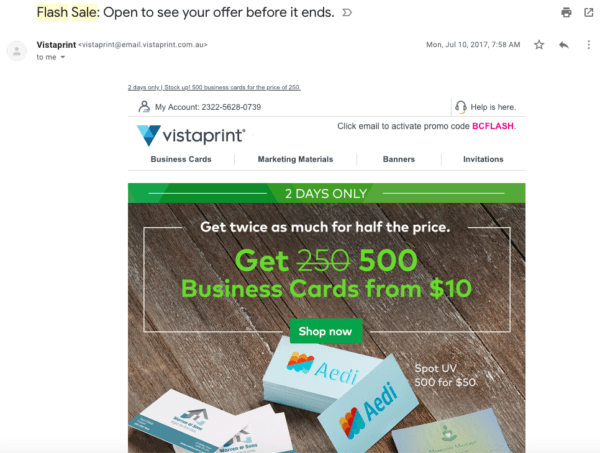
3. Free samples or low-priced products
One of the hardest things to do in eCommerce is to build trust with potential customers so that they have faith in the quality of your products. You can overcome this by offering free samples of your product for the price of shipping, or an extremely low-priced product where you don’t make a margin, to get your quality products in the hands of more people.
This tactic tends to work better when people are likely to purchase a large quantity of one of your products, the product is perishable and will need to be replaced, or you have a line of higher-end products that complement the one you give away for free.
See below how this promotional goods company gives away branded pens with all of their orders:
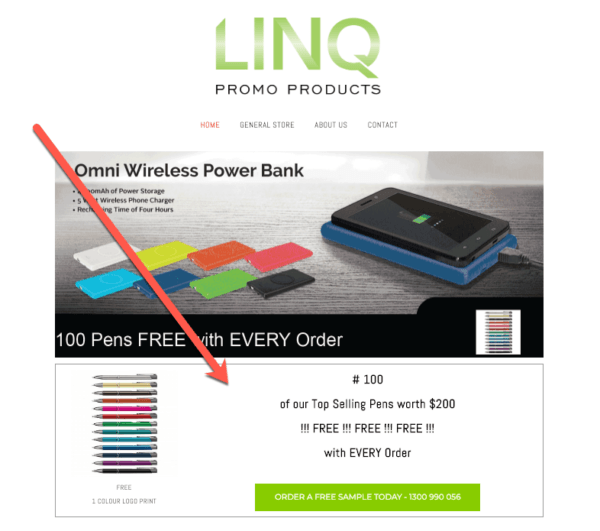
4. Automated re-sales for replenishment
It’s common for eCommerce stores to get stuck in the one-product purchase arena – whereby a customer buys a product from your website, they’re happy with it, but you don’t give them any compelling reason to return and buy again.
Depending on the nature of your product line, there may be an opportunity to generate recurring sales. For example, if you sell a product such as face wash and you know that a typical customer will need to replenish their face wash in a certain timeframe, you can automate and schedule emails or remarketing ads to re-engage those customers and encourage them to purchase a refill.
Alternatively, you can take this to the next level by creating a subscription model for your product-based business. This is a popular trend in a number of industries.
Here are three examples:
Birchbox – Beauty
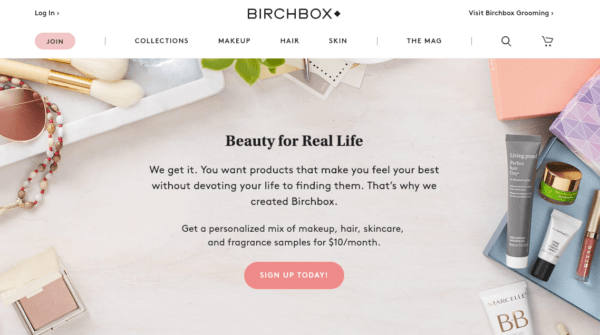
Grass Mats – Pets
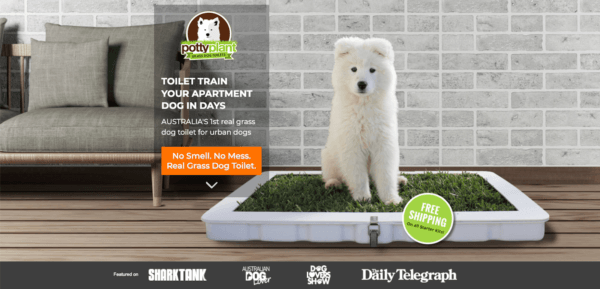
Socks – Clothing
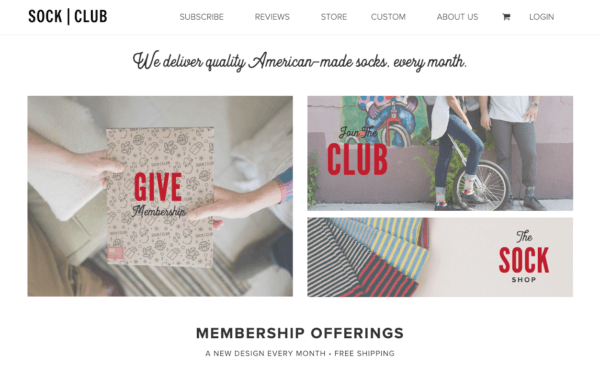
5. Multi-purchase deals
This eCommerce promotion idea is an old favorite of retail stores both online and off.
But just because it’s old, doesn’t mean it isn’t effective…
By offering customers a deal if they purchase multiple products – such as 2 for 1 or buy 2 and get 1 free – you are increasing the likelihood of a purchase based on the psychology of the individual thinking they have secured a great deal.
Of course, you should only offer these deals on products that have an adequate margin to make it profitable.
Here is a 2 for 1 holiday deal from online travel retailer Trip a Deal:
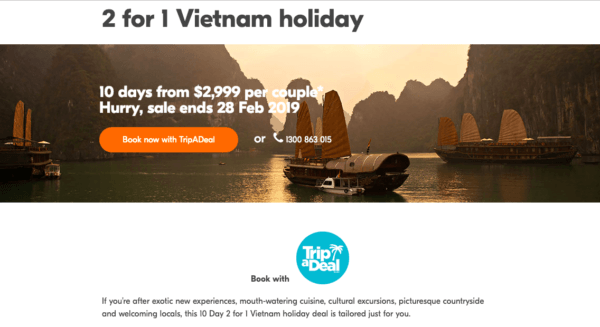
6. Exclusive or complementary cross-sells
Cross-sells are a great way for eCommerce stores to increase their average order value by offering interesting or complementary products to buy-ready customers at the time of purchase.
The most common cross-sell for online stores is the complementary cross-sell, which strategically positions a product alongside the product a customer has in their shopping cart to improve or partner with it. For example, popcorn for a popcorn maker.
An alternative to the traditional cross-sell is to offer an exclusive product that is only available when you purchase something specific. The fact that something is only available whilst purchasing another product makes it scarce and exclusive, enticing more customers to take the bait.
Whichever type of cross-sell you choose, the most effective ones have both personalization and smart automation to customize the offer for each individual.
Airlines regularly use both cross-sells and up-sells during checkout to increase their average order value:
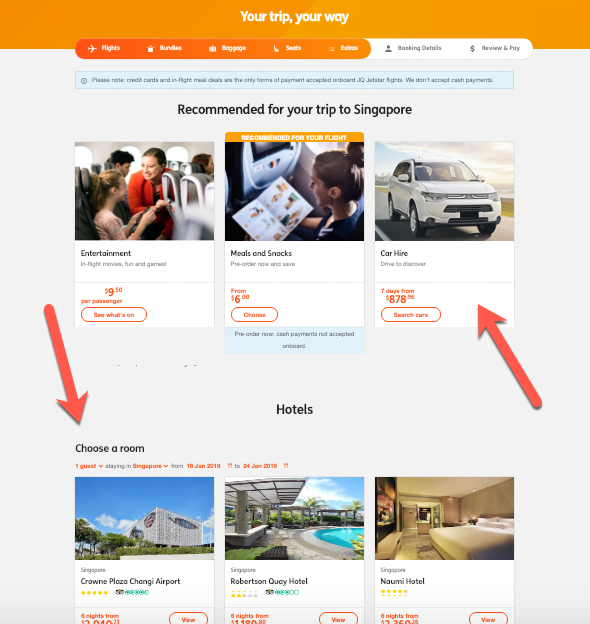
7. Bundle best-sellers with high margin products
Bundle offers are another long-standing, and highly effective, promotional tactic for retail stores to increase their average order value.
The general concept is that you take a small cluster of products, package them up as a “Bundle”, and then offer them at a collective price which is cheaper than if a customer was to purchase each of them individually.
The best bundle offers have the following characteristics:
- The products are complementary.
- Each individual product in the bundle is attractive as a standalone purchase.
- The bundle is, of course, cheaper than purchasing each of the individual products separately.
- The bundle includes at least one high-margin product so that you can make a profit from the reduced sale price.
Here’s an example bundle deal from Best Buy:
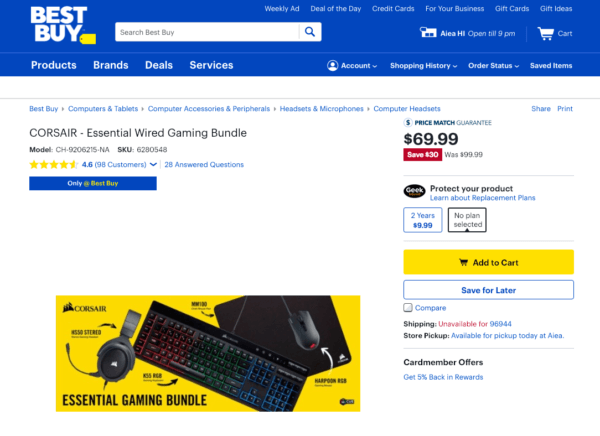
8. Limited time coupons or discounts
Urgency is a powerful psychological marketing tactic for eCommerce stores as it accelerates a customer’s purchase decision and reduces the chance that they will leave your site without buying.
An effective way to elicit urgency is by offering coupons or discounts which are only available for a limited time. You could run this as a standalone promotion for a set period of time, or alternatively, you could set up expiring coupons that are delivered to prospects or customers at strategic times in your relationship. This may be when they sign up for your email list, make their first purchase, or if they have been inactive for a certain period of time.
Online photo provider Bigstock regularly re-engages customers with limited time coupons:
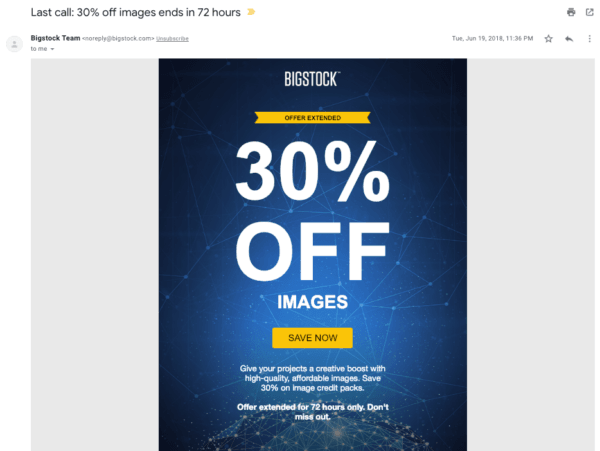
9. Automate abandoned cart recovery
According to research conducted by the Baymard Institute, the average online cart abandonment rate is 69.89%. That means that almost 70% of people who are adding an item to their shopping cart on an eCommerce store are not following through with the purchase.

The key to recovering abandoned carts is to adopt smart automation and re-engagement strategies such as triggered emails, targeted remarketing ads, and timed on-site popups.
Online sports apparel store Logo Sportswear offers a 15% discount to recover abandoned shopping carts:
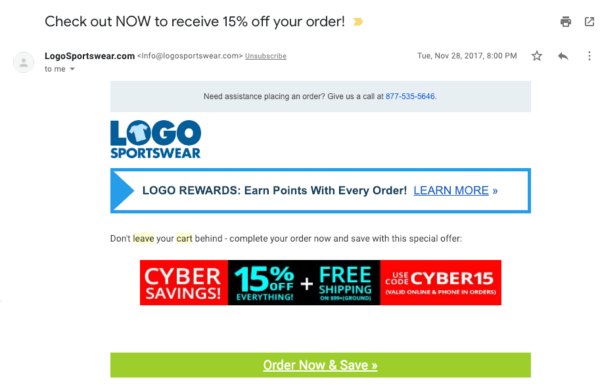
10. Cross-platform selling
As consumers become more accustomed to buying goods from multiple online platforms – such as online marketplaces and social media – eCommerce stores need to adapt.

As well as your website, you could look to sell your products on Facebook, Instagram, eBay, Etsy, Amazon, and other online marketplaces.
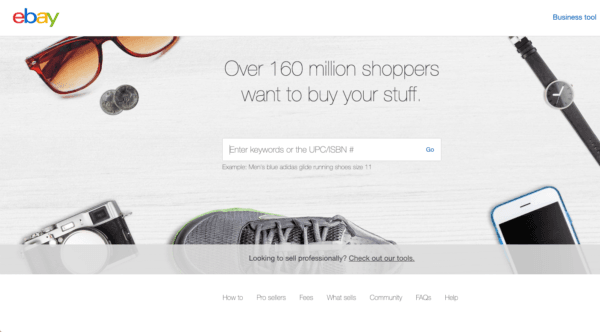 11. Live chat engagement
11. Live chat engagement
Today’s consumers are impatient. They want products shipped in days or even hours. They expect their questions answered immediately, or they’ll simply go to the next website and buy what they want from there. They are spoiled with choice.
You can meet this desire for immediate action with a live chat widget on your website. Not only is this a direct channel for customers who have questions, but it can also be a way to engage website browsers and convert them into buyers.
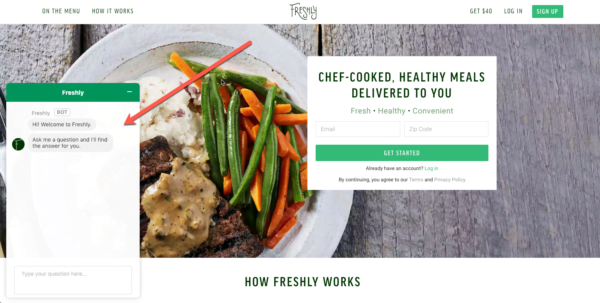
12. Get personal with recommendations
In 2017, 90% of the U.S. population found personalized marketing appealing. It’s no longer good enough to send catch-all email campaigns or run generic ad campaigns. You need to personalize the experience for your customers based on their behavior.
One way to personalize the customer experience is to recommend products based on previous website behavior and purchase history. You should aim to provide personalized product recommendations via email, in on-site widgets, or with remarketing ads.
Amazon are the masters at this:
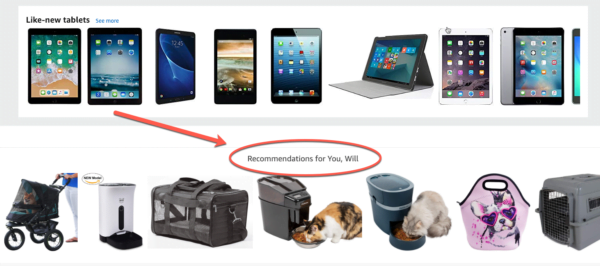
13. Run an influencer campaign

Influencers are all the buzz in digital at the moment, especially in eCommerce. But there is a good reason for this trend – influencers can help you build immediate and lasting trust with your customers at scale.
The key to a successful influencer campaign is to find influencers who have genuine and consistent engagement with your ideal audience and work with these individuals on an authentic content-driven campaign.
Here is an example of an influencer post on Instagram:

14. Leverage user-generated-content (UGC)
UGC is 35% more memorable than other media such as ads or brand-created content.
For the most part, users create content from their desire to play a greater part in a brand’s community of followers.
UGC can be extremely powerful because it provides social proof, increases your exposure to a new audience, and builds trust by association.
The most common sources for UGC that your eCommerce brand can leverage are social media posts, blog post product reviews, and customer reviews.
National Geographic, for example, has a UGC program called “Your Shot”, where they encourage photographers to contribute photos for the chance to be featured on their website:

15. Have a branded hashtag
A branded hashtag can improve the discoverability of your brand on social networks. They also help avid followers deliberately associate themselves with your business – something that is very common when an eCommerce store is positioned as a lifestyle choice, not just a seller of products.
Watch brand MVMT use the hashtag #jointhemvmt, to engage with their followers and encourage user-generated photos of their product line. The hashtag has been used over 130,000 times on Instagram alone:

16. Localize your marketing
The eCommerce landscape is very much a global endeavor these days. There is no reason, except an extended shipping period, why you can’t sell products to just about any country in the world. This means that scaling up is faster and more attainable than ever.
However, the desire to “Go Global” can at times reduce the effectiveness of your marketing efforts. People tend to respond more positively to location-based marketing due to differences in culture and product taste. This is why big eCommerce stores have multiple websites for different locations, as well as locally-targeted ad campaigns, variable product lines, and location-based deals or offers.
Watch brand Daniel Wellington is one example of a website that has a country selection menu for visitors so they can display location-based messaging:
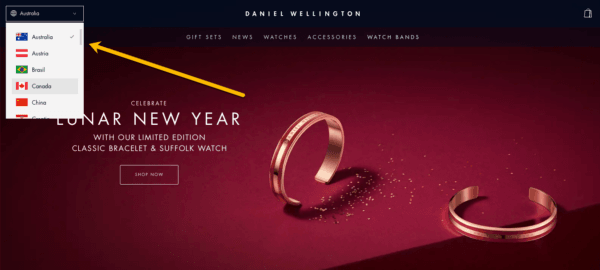
17. Optimize product pages
Any seasoned eCommerce business will appreciate that the success of your store is much more than just having a great product. As website traffic grows and your brand matures in the market, eCommerce becomes a game of optimization. Everything you do is an attempt to increase sales conversions, encourage repeat purchases, or increase the average order size of customers.
One element of this optimization equation is the performance of your product pages.
Here are six things that every good eCommerce product page should include:
- A unique and compelling product description.
- A series of high-definition product images that show all aspects of the product.
- A diagram or size-guide that helps visitors visualize the actual size of the product.
- Social proof, in the form of reviews or testimonials.
- Clear pricing and delivery instructions.
- Personalized product recommendations.
You can test, change, and optimize all of these elements to increase your conversion rate over time.
This product page from dog camera brand Furbo is a good example of a well-optimized page:
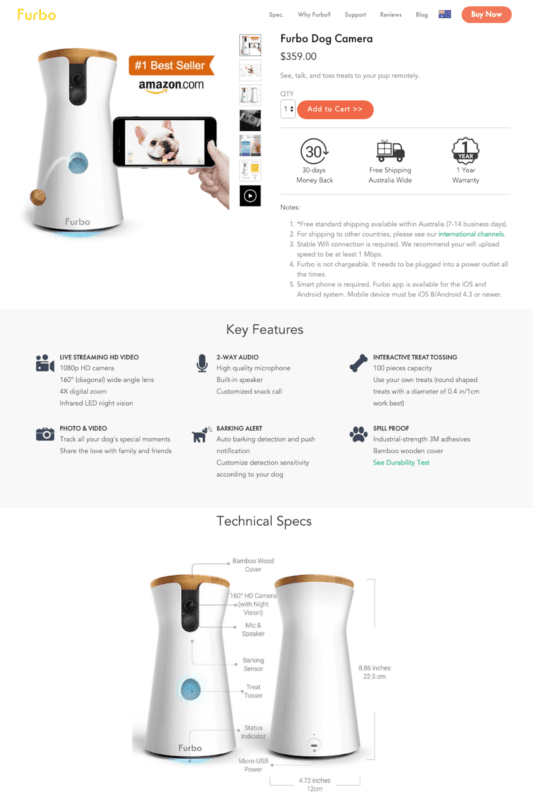
18. Optimize the checkout process
Similar to the product pages on your website, you can look to optimize the checkout process. Remember, a significant number of people that add products to their shopping cart end up leaving your site before making a purchase. Sometimes this is due to an overly complex checkout process.
Your checkout process needs to be as easy-to-understand as possible. Look to remove any barriers to a customer completing the process and test each element to improve your conversion rate.
Some things you may like to consider when going through this optimization process include:
- Provide a guest checkout option, so users don’t need to sign up in order to make a purchase.
- Include a step-by-step progress bar of the checkout process, so each customer feels like they are getting closer to their destination.
- Make the checkout process isolated from the rest of your site, so that there are no distracting menu items or other things a customer can choose to do. Like this one from dog backpack brand K9 Sport Sack:
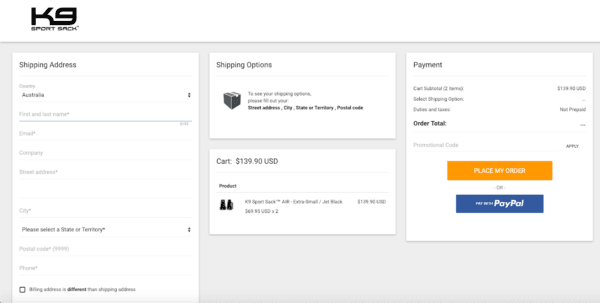
- Avoid adding shipping costs in the last step, make these clear and upfront prior to a customer entering the checkout process.
- Show customers that their details are safe with HTTPS and other security badges.
19. Start a loyalty program
Loyalty programs have been an eCommerce favorite for many years now. They have the potential to improve your relationships with customers, increase repeat purchases, gather valuable customer data, and reduce marketing costs.
But you can’t simply start a loyalty program without proper planning because they require a lot of attention over time. From a customer’s perspective, they should be simple and easy to join. They also require regular communication, offers, and special deals to keep customers engaged and happy. For example, many big eCommerce stores would have a full-time employee managing their loyalty program.
Here’s an example VIP rewards program from dress brand Esther:
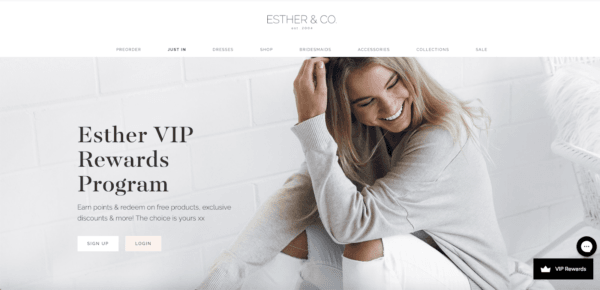
20. Tap into product comparison sites
Product comparison sites have been a growing trend in recent years. They provide consumers with impartial third-party opinions of products to help them make informed decisions about which products they should purchase.
These days, there are comparison websites for just about anything you can think of. And they are a HUGE and highly targeted traffic source for eCommerce stores. Do some research into the most appropriate comparison websites in your niche and look to have your products featured.
Product Review is an example of a comparison site with a large range of product categories:
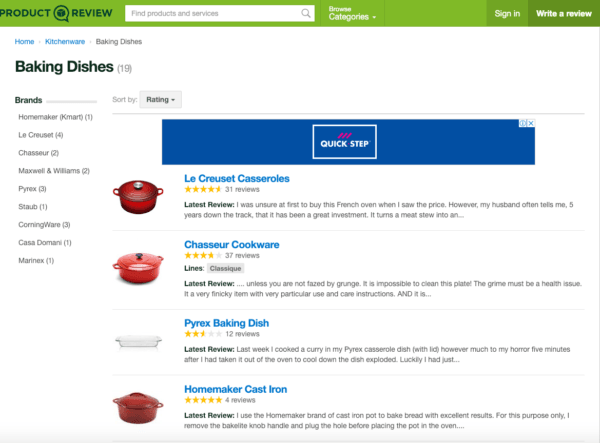 Product comparison and review website.
Product comparison and review website.
21. Rank for long-tail keywords
For many eCommerce store owners, search engine optimization (SEO) is a foreign concept that is predominantly focused on their products showing up on page one of a Google search – if they’re seriously lucky and well-established.
The truth is, there are a LOT of opportunities for eCommerce stores in just about any niche to get organic search traffic from publishing helpful content on their websites. You just need to know where to look.
I recommend using a tool called KWFinder to conduct keyword research and identify a range of long-tail phrases that your site could potentially rank for. Then, create blog articles that answer these queries.
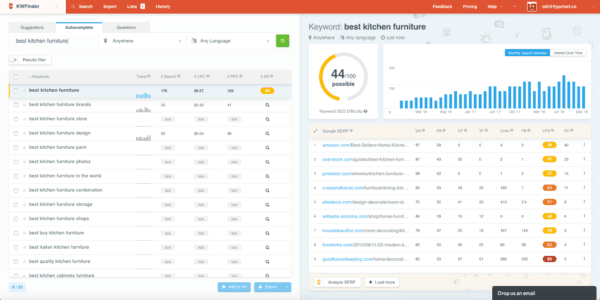
Keyword research tool.
It sounds simple, but you’d be surprised how many eCommerce stores are ignoring content marketing as a means for attracting qualified traffic to their website. Instead, opting for a paid-only Google strategy that gets expensive very quickly.
Sources
21 Super Simple eCommerce Promotion Ideas to Boost Your Online Sales


